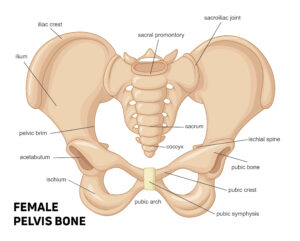So, you’re pregnant, (congratulations by the way), you’ve been told that you need to start your pelvic floor exercises (or Kegels as they’re otherwise known), but why? Are they essential? Surely not everyone has to do them the minute they become pregnant? (I hear you say)! Well there is a little more to it than that, read on…..
What are Kegels and are they different to pelvic floor exercises?
You might already know what they are and even how to do them but here is a very brief explanation for the novices amongst us:
Kegels are exercises for your pelvic floor muscles (the muscles that help hold in the wee when you’re bursting). The exercises involve a series of squeezes and holds to help strengthen this group of muscles. ‘Kegels’ is a term that is used in the United States more (the bloke who first discovered their use was called Dr Kegel), whereas the UK and Europe tend to refer to these exercises as Pelvic Floor Exercises, but they are one and the same thing. You will find lots of different looking Pelvic Floor Exercises online and in various classes but their aim is still to strengthen the pelvic floor muscles by contracting and relaxing them (variety has been added over the years to keep ladies interested in them because, let’s face it, they can be a little boring).
What is so important about the pelvic floor when it comes to pregnancy?
The pelvic floor muscles are a vital part of your pelvic health and function, aiding things like continence (urinary and faecal), sexual function (pelvic floor contractions = orgasms!), supporting the weight of the baby when you are pregnant and pushing the baby out during a vaginal labour.
The pelvic floor muscles go from the front of your pelvis (pubic bone) to your tailbone (coccyx) and act like a hammock for the organs (the bladder, bowel, and uterus) inside the pelvis. Whether you have a vaginal or caesarean birth, your pelvic floor muscles are still put under several months of stress due to the weight of your growing baby resting on them. If these muscles become weakened, stretched or torn during pregnancy (or birth) you are at risk of incontinence, pelvic pain, sexual dysfunction and prolapse.

So, does everyone have to do these exercises?
The short answer is: No
But there is a longer answer that is worth a read because very few people fall into the ‘No’ category.
There are certain circumstances when doing Kegels or Pelvic Floor Exercises can do more harm than good (and this is never discussed in antenatal appointments). Some women have pelvic floor muscles that are too tight and are working overtime. This is found most often in women who are:
- More active with exercise (especially when it involves a lot of ‘core work’).
- Under a lot of stress / suffer with anxiety.
- Dealing with pain (often associated with pelvic trauma, infection or inflammation).
- Dealing with symptoms following pelvic surgery including prolapse surgery and hysterectomy.
- Prone to recurrent infections such as cystitis or thrush.
- Suffering with conditions such as; painful bladder syndrome, vaginismus, vulvodynia and endometriosis.
How would I know if my pelvic floor was tight or over active though?
Well, here are some of the symptoms you might suffer with:
- Difficulty urinating and emptying the bladder (this could be painful).
- Painful bowel movements.
- Lower back, pelvic, hip, tailbone and / or genital pains.
- Pain during intercourse, when you insert a tampon or have a gynaecological examination.
- Kegels / Pelvic Floor Exercises are painful to do.
Basically, if you suffer with pelvic, abdominal, hip, back or genital pains during your pregnancy (and especially if Kegels cause increased discomfort) then speak to a Women’s Health Physiotherapist / or gynaecological specialist. They will be able to check how your pelvic floor muscles are working and advise you on the best course of action based on their findings. This might involve a series of pelvic relaxation exercises or using aids to help ease the pains that you are experiencing throughout your pregnancy.

I don’t have any symptoms, what are the chances of me actually having any pelvic floor issues?
It has been found that almost 50% of pregnant ladies will suffer with some form of pelvic floor disorder following their pregnancy (if no preventative measure is carried out). Looking at that from a ‘glass half full’ perspective means, that just over 50% of ladies will suffer no pelvic floor issues following the birth of their baby.
Great!! But is it worth the risk? I would say………Probably not! There is quite a lot of evidence out there which supports the fact that doing Kegels throughout your pregnancy can help prevent symptoms of incontinence and prolapse and improve sexual function. It has also been found that doing Pelvic Floor Exercises throughout your pregnancy can help reduce the duration of the second stage of labour (if that doesn’t sell Kegals to you then nothing will)!
My pregnancy is almost over and I haven’t done any pelvic floor exercises, is it too late?
Not necessarily. If you are unfortunate enough to suffer with any of the symptoms associated with pelvic floor dysfunction then Kegels have still been shown to help, even if they are only started in the postnatal period. Evidence is less reliable when it comes to helping prolapse symptoms but studies have shown good results when treating urinary or faecal incontinence and sexual dysfunction.
In summary….
Evidence suggests that all ladies should do Pelvic Floor Exercises during their pregnancy if they are symptom-free. This can help to prevent incontinence, pelvic pain, pelvic prolapse and sexual dysfunction after your pregnancy. All ladies are at risk of these symptoms regardless of BMI, fitness and strength so they are worth doing as a preventative measure. If Kegel exercises cause any pain then you should speak to your healthcare provider or a Women’s Health Physiotherapist to get a full assessment and discuss a new treatment approach. It is never too late to start pelvic floor exercises but prevention is always better than treatment!


